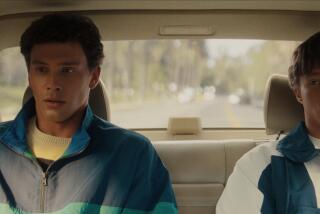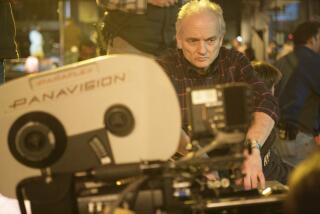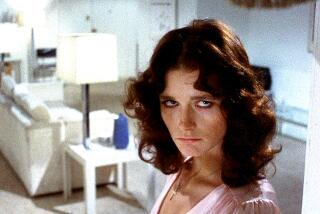Hitchcock’s Throwaway Masterpiece : Thirty years ago, Alfred Hitchcock took a modest tale of a psychopathic motel keeper and his ever-present mom and turned it into a hit horror classic. It made taking a shower a test of nerves for years to come.
“The Cape Canaveral Monsters,” “The Stranglers of Bombay,” “Mill of the Stone Women,” “Circus of Horrors.” Let’s be kind; 1960 was not shaping up as a banner year for horror movies.
So no one expected much when Alfred Hitchcock, in a seeming act of creative slumming, chose--as his last official act for Paramount Pictures--to direct a disturbing, offbeat tale of a psychopathic motel keeper and his ever-present mom in an adaptation of the Robert Bloch novel “Psycho.”
“Psycho” opened nationally on June 16, 1960, and screen horror has not been the same since. Remember . . . the classic shower sequence, Bernard Herrmann’s screaming string score, the gritty black-and-white shadowy images deftly choreographed by the inventive director. All have combined, nearly 30 years after its release, to make what was initially intended as a low-budget “programmer” the seminal film in a new era of cinema horror.
“It’s definitely a classic,” says Jonathan Kuntz, an assistant professor of film and television at UCLA. “It was one of the first horror films to make the horror come out of the American family.”
Critic and author Leonard Maltin wrote in his “TV Movies and Video Guide”: “The picture, despite decades of parody and imitation, has lost none of its power to manipulate audience’s emotions.”
But “Psycho” is not a consensus masterwork.
“I don’t think ‘Psycho’ was Hitchcock’s best work,” claims actress Vera Miles, who played Lila Crane in “Psycho” and appeared in Hitchcock’s earlier film “The Wrong Man.” “He did so much better work but, unfortunately, ‘Psycho’ has become his trademark and I think that’s sad.”
Whatever its standing on individual hit lists, “Psycho” has left indelible impressions in the minds of subsequent filmmakers, those shameless--and often unabashed--imitators of the Hitchcock style. Brian de Palma has rejected parallels drawn by critics between his and Hitchcock’s style, but few others have objected to their films being given that evocative label “Hitchcockian thriller.”
“Psycho” has done less well at spawning sequels than imitations. “Psycho II,” released in 1983, and “Psycho III,” released three years later, didn’t remind many people of the original, even though Anthony Perkins reprised the role of Norman Bates in both outings. Universal Pictures is now planning “Psycho IV.” Meanwhile, the pilot to a sitcom, “Bates Hotel,” didn’t cause a ripple on the Nielsen ratings. (At the same time, Robert Bloch has continued to sequel his original book, as well. Part three in his series--”Psycho House”--was published in February.)
Whatever made “Psycho” work, and most people think it was Alfred Hitchcock, nothing has worked quite so well since.
“I think ‘Psycho’ bothered people on a level that the horror films that came before and after never even attempted,” says Joseph Stefano, who wrote the original “Psycho” screenplay. “ ‘Psycho’ gave us nice people who we learned to like and then forced us to watch them being brutally murdered by another seemingly nice person, Norman Bates, who was also easy to care about.”
Dr. Louis J. West, a professor of psychiatry at UCLA, says that “Psycho” was not the first movie to address the subject of homicidal maniacs, “but it was a film that very much surprised people. What had the greatest effect was the shower sequence. The blood running down the drain was a major startle effect that broke the usual pattern of expectation that people in 1960 had. You also could never be sure who was wielding the knife, which added to the surprise.”
“I think the most daring thing Hitchcock did was to kill off the lead character, Marion Crane (Janet Leigh), in the first reel,” says Saul Bass, a graphic designer who storyboarded and, with Hitchcock’s assistance, directed the famous shower sequence. “That was the most shocking thing in the film and is still considered an outrageous notion in today’s filmmaking circles.”
UCLA professor Kuntz agrees with Bass’s assessment.
“The death of Marion in the shower scene is an incredible moment in the film because it leaves the audience wondering who they are going to identify with next. And the only one they are left to identify with is somebody who turns out to be a maniac. It is a style Hitchcock toyed with in the films ‘Vertigo’ and ‘Rear Window’ but finally introduced in ‘Psycho’ in a totally unique way.”
Bloch, who was already an established mystery and horror writer prior to writing “Psycho,” says the movie “made people realize that it was possible to utilize non-supernatural and alien elements as sources of suspense and horror.”
“Psycho’s” screen birth came about in 1959 as the result of a professional challenge to Alfred Hitchcock by Alfred Hitchcock.
“Hitchcock was just coming off the picture ‘North By Northwest,’ ” remembers “Psycho” assistant director Hilton Green. “That had been Hitchcock’s highest-budgeted picture to date and he wanted to prove that he could make a quality film and not spend a lot of money.” “Psycho” was made for about $800,000.
Stefano claims that Hitchcock’s desire to do a film quick and dirty was inspired, in large part, by the work being done at the time by Roger Corman.
“I remember Hitchcock telling me, ‘There’s a company called American International Pictures that is doing fantastic things with suspense and thriller movies made for under $1 million.’ He wondered what would happen if he put the same hand that usually got multimillion-dollar budgets to a film with a budget of well under a million.”
The vehicle for Hitchcock’s vision arrived in the form of a recommendation that the director read “Psycho,” a fictional story loosely based on the real-life grizzly murders and mutilations committed by a Michigan man named Ed Gein. Hitchcock fell in love with what he viewed as Bloch’s “workaday characters and dingy locales” and purchased the film rights to the novel in May, 1959.
Bloch, who says he had no idea his novel had the potential to be made into a movie, was happily surprised when he discovered someone had bought the film rights. He was pleased when he discovered it was Hitchcock.
“The rights had been bought through a blind bid and so I had no idea who had bought it,” he said. “When I found out it was Hitchcock, I was greatly relieved because I felt he was the only one who could adequately handle the material.”
Unfortunately, Bloch recalls that Paramount did not share his confidence.
“It was looked upon by Paramount as a potential bomb and so the studio put every possible roadblock in Hitch’s path. They gave him a small budget and told him there was no sound stage on the Paramount lot for him to use.”
Stefano, likewise, remembers “that Paramount felt the movie would not do very well or have much of an impact.”
Hitchcock, who was shooting his TV series “Alfred Hitchcock Presents” for Universal, finished “Psycho” for Paramount--using his TV crew--but never worked for the studio again. (Universal eventually acquired the rights to “Psycho” and the sequels have been Universal productions.) James P. Cavanaugh was assigned to write the “Psycho” script, but when Cavanaugh’s first draft did not measure up, Hitchcock brought in Joseph Stefano, who had just written the well-reviewed film “The Black Orchid” and Playhouse 90 TV movie “Made in Japan.”
Stefano read Bloch’s novel and, during his initial meetings with Hitchcock, expressed some problems he had with it.
“Bloch’s novel started with Marion Crane arriving at the motel and immediately being killed,” he remembers. “My feeling was that, since I did not know anything about this girl, I wasn’t going to care about her when she was killed. So we backed the story up a bit and learned something about her so that when she was killed it would have more impact.
“I also had a problem with the fact that Norman Bates, in the novel, was a 40-year-old drunk who looked like Rod Steiger. He was a character who was so obvious and unsympathetic that it wouldn’t take long for people to figure out who the killer was. Hitchcock came back with ‘What if Anthony Perkins played Norman?’ It brought to mind an image that I knew would really upset people,” says Stefano.
Perkins, then 27, was a star on the rise and, like Hitchcock, owed Paramount one more film on an old contract. Perkins readily agreed to what was a chancy career move.
For the pivotal role of Marion Crane, Hitchcock considered such actresses as Eva Marie Saint and Shirley Jones before deciding on Janet Leigh. Vera Miles, fresh off the film “Five Branded Women” and consequently forced to wear a wig throughout the making of “Psycho,” agreed to the secondary role of Lila and claims to have not been bothered by the film’s subject matter.
“I read the book but was not concerned because I knew Hitchcock’s style was not overt,” she recalls. “I never felt Hitchcock would be guilty of extreme gore and eyeballs popping out of the screen.”
“Psycho” began filming on Nov. 30, 1959, on Soundstage 18 at Universal Studios under a cloak of secrecy. Hitchcock insisted on a closed set at all times and, in order to keep the film’s title secret, insisted that all in-house communication regarding the film be tagged with the code name “Wimpy.” A lot of secrecy for a film that even those connected with the project felt was headed for B-movie oblivion.
“Nobody working on the film had a clue that ‘Psycho’ would end up being a classic,” says assistant director Green. “As the film progressed, however, we did begin to get the feeling that it would end up being more than just an exploitation picture.
“In a sense, ‘Psycho’ was typical of Hitchcock in that he was trying . . . to take a sequence or two and attempt, with a camera move or a different angle, to achieve something different. I know there was a lot of discussion about how to shoot the scene where Arbogast comes up the stairs and is attacked by Mother. Hitchcock did not want Mother’s true identity revealed at that point and so a device was designed to lift the camera up and behind Mother and shoot her from the back. And then, of course, there was the shower scene.”
Bass recalls that the montage effect he designed for that scene was contrary to Hitchcock’s normal bag of camera tricks.
“The way the shower scene was laid out was very un-Hitchcock. Hitchcock loved long convoluted shots that contained a lot of tracking and camera moves. I wasn’t sure how Hitchcock was going to take my notion of fast cutting and montage, but he seemed very happy with it and that’s the way it was shot.”
Like many great movie scenes, the question of who actually directed the shower sequence has become the stuff of legends. Hilton Green says that Hitchcock definitely directed the scene. Other rumors point to an unnamed German film crew. Many, including Saul Bass, claim that Saul Bass directed it.
“I was on the set the day the scene was scheduled to be shot,” says Bass. “Hitchcock had me set up the first shot. When it came time to film, Hitchcock told me, ‘You know what to do, go ahead.’ I swallowed hard and said ‘roll camera.’ Hitch sat back in the director’s chair, nodded his head occasionally and encouraged me.”
“Psycho,” nine days over its projected 27-day shooting schedule, wrapped principal photography on Feb. 1, 1960. Hitchcock expected to have a battle on his hands with the movie industry censors over a second of nudity in the shower scene, but it never materialized, and by late May, less than four weeks before the film’s scheduled release, the director and Paramount got down to the business of marketing. Uppermost in Hitchcock’s mind was the fear that the first audience to see the film would promptly give away the ending and kill the picture’s suspense.
To make sure the film got off to a cleanly suspenseful start, he talked the studio into not screening “Psycho” for critics prior to its release. He also instituted an admissions policy that was daring then but common afterward: “No one . . . but no one will be admitted to the theater after the start of each performance of ‘Psycho.’ ”
Hitchcock was not above exploiting the film’s saucier elements. Prominent on “Psycho” posters was the image of Janet Leigh in her bra with the shirtless John Gavin.
“Psycho” opened in New York’s DeMille and Baronet Theaters on June 16 and was an immediate sensation. In California, police were called in to unsnarl traffic outside a drive-in theater where the film was playing. Patrons standing in a driving rain outside the Woods Theater in Chicago threatened to tear it down if they were not allowed in.
The critics were not as impressed. “A blot on an honorable career,” wrote New York Times film critic Bosley Crowther. By the end of the year, Crowther had changed his mind and listed “Psycho” among the year’s top 10 films. The reviewer for the London Daily Express was equally unkind. “It is sad to see a really big man (Hitchcock) make a fool of himself by dredging this kind of cesspool.”
“Psycho’s” early critical battering wasn’t helped when two young men committed murders that they claimed were inspired by repeated viewings of “Psycho.” Hitchcock’s response to the killings: “These boys have killed before. I want to know what movie they saw those times or did they do it after drinking chocolate milk?”
Bad reviews and alleged copy cat killings did not stop “Psycho” from grossing a reported $18 million by the end of its first year in release and both Hitchcock and Janet Leigh were nominated for Academy Awards. But while “Psycho” has gone on to become a classic, those involved in its creation were not necessarily better for the experience.
“I think doing the screenplay for ‘Psycho’ has done me more harm than good,” says Stefano. “Through the years it has made it very difficult for me to get some of the other kinds of pictures that I would have liked to have gone on to. I never used to think there was typecasting among writers until after I did ‘Psycho’ and, years later, got involved in ‘The Outer Limits’ television series. It got so bad that I would sometimes go a year or two without doing anything rather than do the things that were being offered to me.”
Bloch says he suffered too.
“There was no prestige attached to it for me,” the novelist says. “The industry just pasted the ‘Psycho’ label on my forehead and I’ve had to wear it ever since. Many times wearing that label was a benefit, but it also constantly typed me even when the work I was doing was far removed.”
Vera Miles, who reprised her role of Marian’s sister in the first sequel, said the film had no negative impact on her career. Hilton Green has at least gotten more direct work from it, having worked on both sequels.
“Psycho” helped a lot of young filmmakers who used it as their inspiration. UCLA professor Kuntz calls “Psycho” “the great grandfather of the slasher picture” but doesn’t think the inspired have done the inspiration proud. “People who make horror films have certainly learned some lessons from ‘Psycho,’ ” he says. “But what has more often than not happened is that people who make films like ‘Friday the 13th’ have basically ripped off what they feel works on an exploitation level, namely the sex and violence, and tossed out the complexity and depth of character that was a high point in Hitchcock’s film.”
“I believe ‘Psycho’ started a string of pictures that went off in the wrong direction,” says Stefano. “Unfortunately the problem is that now people tend to think of ‘Psycho’ as a slasher movie and it is so much more than that. There were only two murders in the entire movie.”
But it is the memory of one of those murders, according to Saul Bass, that will stick in people’s minds long after they’ve forgotten everything else about the movie.
“I remember thinking when we were making the movie that the shower scene was going to be a neat little murder. Now we know it was much more than that.”
More to Read
Only good movies
Get the Indie Focus newsletter, Mark Olsen's weekly guide to the world of cinema.
You may occasionally receive promotional content from the Los Angeles Times.










